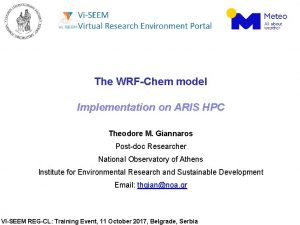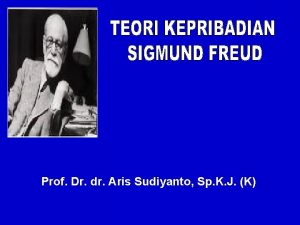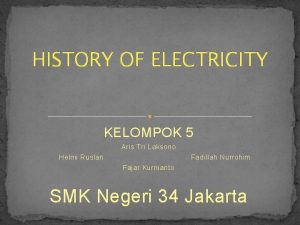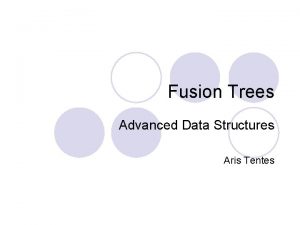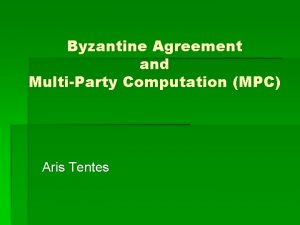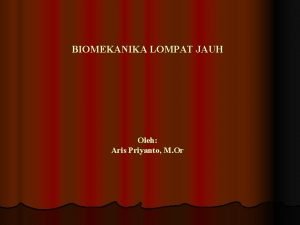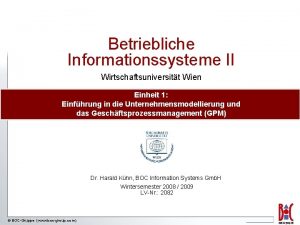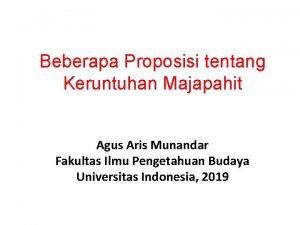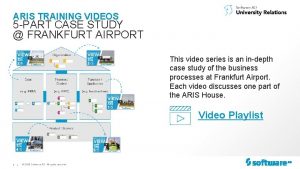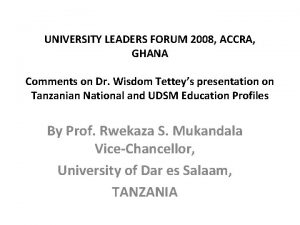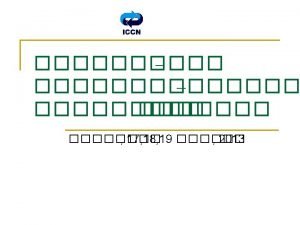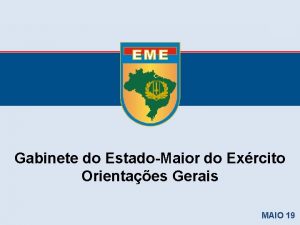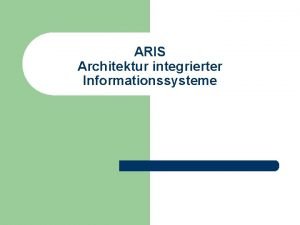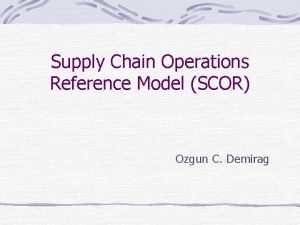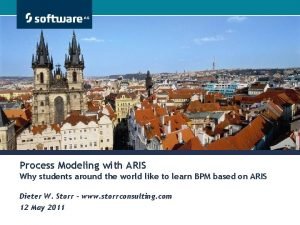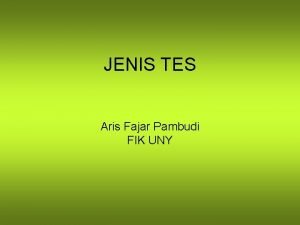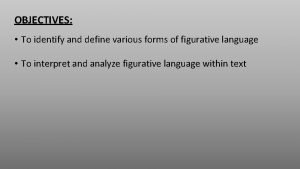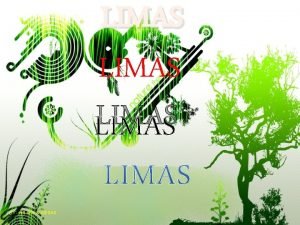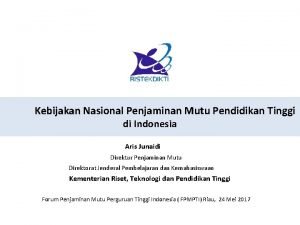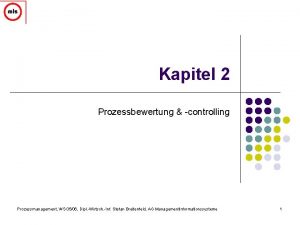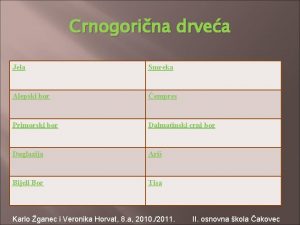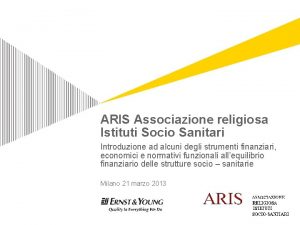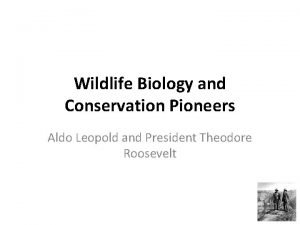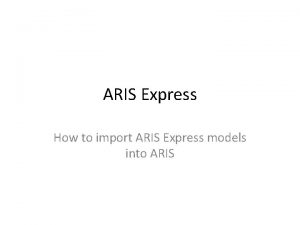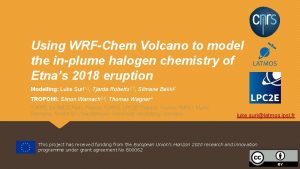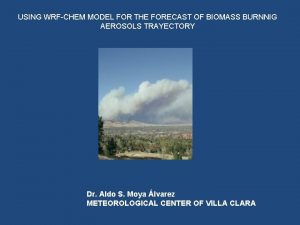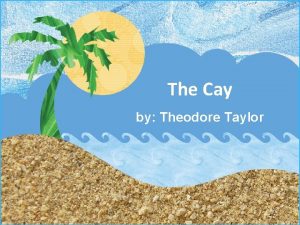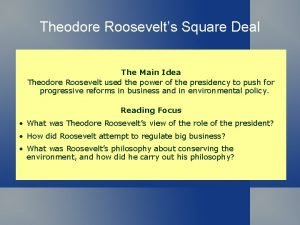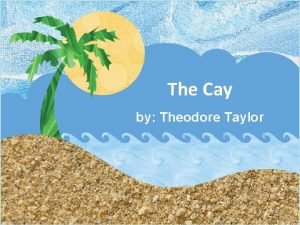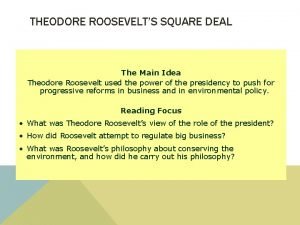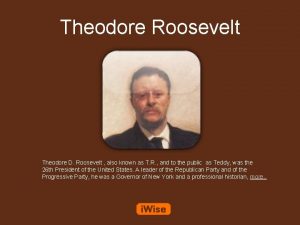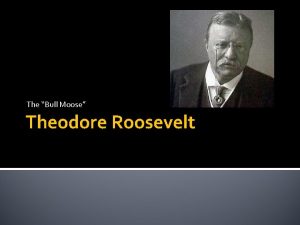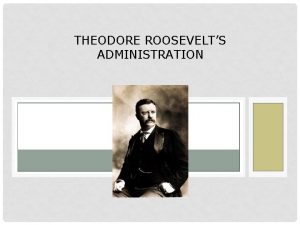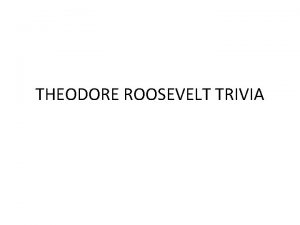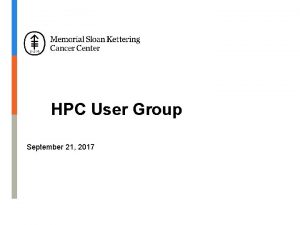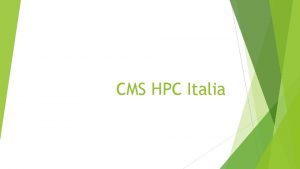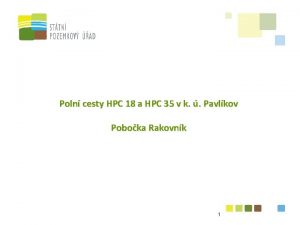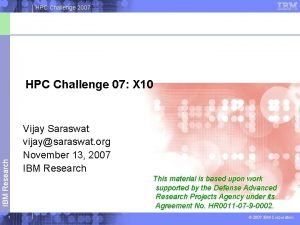The WRFChem model Implementation on ARIS HPC Theodore

























- Slides: 25

The WRF-Chem model Implementation on ARIS HPC Theodore M. Giannaros Post-doc Researcher National Observatory of Athens Institute for Environmental Research and Sustainable Development Email: thgian@noa. gr VI-SEEM REG-CL: Training Event, 11 October 2017, Belgrade, Serbia

What is it? A version of the WRF model that can be used for the simulation of trace gases and particulate matter simultaneously with the meteorology (Grell et al. , 2005) • Online chemistry, fully embedded within the WRF • Consistency: same grid structure (vertical, horizontal), same physics for sub-grid scale transport, no time interpolations • Perfectly suited for examining meteorology-chemistry feedbacks on local to global scales (climate change) • Suitable for operational air quality forecasting on regional to cloud-resolving scales VI-SEEM REG-CL: Training Event, 11 October 2017, Belgrade, Serbia

Why ‘online’ is important? “Eventually though, a migration to an integrated modeling system will provide new opportunities for weather prediction modelers as well. The simulation of chemical species will allow identification of shortcomings in currently used forecast models as well as lead to better use of meteorological data assimilation” • More realistic representation of the atmosphere: the offline approach introduces errors that increase with increasing grid resolution • Numerically more consistent: same grid structure (horizontal, vertical), no time interpolation • Proven improvements in medium-range weather forecasts Nevertheless: • Computationally very expensive • Less flexibility for conducting ensemble modeling VI-SEEM REG-CL: Training Event, 11 October 2017, Belgrade, Serbia

How does the ‘coupling’ work? • Advection and diffusion provided by WRF • Sub-grid scale transport carried out by WRF physics parameterizations, PBL schemes and convective parameterization schemes • Chemical processes carried out by WRF-Chem, dependent on meteorological input: emissions (anthropogenic, biogenic, fire, dust, sea salt, volcanic), dry deposition, wet scavenging • Chemical reactions carried out by WRF-Chem: aqueous and gas phase chemistry, aerosols • Chemical radiation processes carried out by WRF-Chem: computation of photolysis rates • Chemistry-meteorology feedback carried out by coupling interface: radiation, microphysics, convection VI-SEEM REG-CL: Training Event, 11 October 2017, Belgrade, Serbia

Installation Similar procedure and dependencies as for installing the WRF model export WRF_CHEM=1. /configure. /compile em_real 50+ compilation options: Serial, DM, SM, Hybrid (DM+SM), numerous compilers and architectures VI-SEEM REG-CL: Training Event, 11 October 2017, Belgrade, Serbia

Quick how-to Procedure similar to a meteorological WRF simulation 1. Setup your modeling domain as you do for a typical WRF simulation. /geogrid. exe 2. Decode forcing data. /ungrib. exe 3. Horizontally interpolate forcing data on your modeling domain. /metgrid. exe Chemistry ‘part’ 1. Select chemistry option chem_opt = ? ? 2. Prepare emissions (users’ ‘job from scratch’) ** will not be covered in this talk 3. Generate initial and boundary conditions (optionally also lower boundaries) for both meteorology and chemistry. /real. exe 4. Run your simulation!. /wrf. exe VI-SEEM REG-CL: Training Event, 11 October 2017, Belgrade, Serbia

Getting started: Read - Think - Design Define your objectives What are your scientific and/or practical objectives? Why do you need to run WRFChem? How will you know that your simulations are successful? You and your scientific problem: ‘to know us better’ Review literature! What are the atmospheric and chemical processes involved? Which are the most important (clouds, radiation, convection, aerosols, etc. )? What is known? Is anything missing? Judge the efficacy of your “simulations-to-do”. Determine available observational datasets What observations are available? Again, become familiar with the processes that you want to study. How will the observations be used for verifying and/or complementing your simulations? Judge the adequacy of your “simulations-to-do”. Prepare your strategy Are you going to focus on a case study? If yes, which one and why? Are there adequate observations for verifying your “simulations-to-do”? Will you set up an operational weather and air quality forecasting service? What are the practical requirements? VI-SEEM REG-CL: Training Event, 11 October 2017, Belgrade, Serbia

Setting up domains First things, first • Target horizontal grid spacing • Resolution of initialization data Most often, you will need to adopt a nesting strategy. Hints • Place domain boundaries away from each other, and away from steep topography • Odd parent-child ratios are preferred (e. g. 3: 1, 5: 1) • Higher horizontal resolution will also require higher vertical resolution • Use at least 30 -35 vertical levels; larger density closer to the ground and to the model top to avoid numerical instability (aka ‘CFL violation’) • Lambert: mid-latitudes, Mercator: low-latitudes, Lat-Lon: global, Rotated lat-lon: regional • Start inside-out (first the nest, then move up) Never forget! Avoid the “grey zone” (4 -10 km) What about computational requirements? VI-SEEM REG-CL: Training Event, 11 October 2017, Belgrade, Serbia

Forcing data Garbage in, garbage out (GIGO) Read - Think - Design General questions: • Do the static data (topography, land use, etc. ) represent my study area adequately? • How ‘good’ are the meteorological forcing data? Does their resolution (temporal, spatial) fit my domain setup? • Do I need lower boundary conditions (e. g. SST)? WRF-Chem specific questions: • Do I need an emission inventory? Do I have one? Does it represent well my study area? Does it have adequate resolution (temporal and spatial) and fit the purposes of my simulation? • What kind of chemistry do I need? Gas phase only? Do I need to include aerosols? VI-SEEM REG-CL: Training Event, 11 October 2017, Belgrade, Serbia

Physics Too many options! Where to start from? • Back to basics: Which processes are important? Review literature. What others did? • Consider first well documented (extensively tested) schemes Hints • Convective schemes are generally not required at dx<4 km • Sophisticated microphysics schemes (double-moment, detailed species) may not be necessary at dx>>10 km • Try to have consistent physics between the domains or use 1 -way nesting • If your simulation spans more than 5 days, you could start thinking to adopt the SST update option What about the meteorology-chemistry feedback? • Certain physics parameterizations may be required to account for e. g. aerosolradiation and aerosol-microphysics interactions VI-SEEM REG-CL: Training Event, 11 October 2017, Belgrade, Serbia

Chemistry (1) Chemistry option Timesteps Input emissions options Anthro/volcanic emissions Input emissions options Photolysis option Dry deposition Biogenic, dust, sea salt VI-SEEM REG-CL: Training Event, 11 October 2017, Belgrade, Serbia

Chemistry (2) Gas/aerosols ICBC Gas/aerosols chemistry switches Wet scavenging Aerosol effects Sub-grid scale processes Biomass burning options Gas/aerosols ICBC Aerosol effects VI-SEEM REG-CL: Training Event, 11 October 2017, Belgrade, Serbia

Dust in WRF-Chem Why dust? • Large uncertainty in estimating global dust emissions: 514 - 4313 Tg/yr • Emissions depend heavily on surface wind speed and soil properties: high spatial and temporal variability • Incomplete understanding of the processes that lead to dust emission: threshold friction velocity, horizontal saltation flux, vertical flux Understanding changes in dust emissions is of paramount importance for both interpreting past and predicting future climate change VI-SEEM REG-CL: Training Event, 11 October 2017, Belgrade, Serbia

Dust emissions options Available dust emission schemes (version 3. 9) All schemes are founded on the GOCART mechanism: Always, examine code! 1. GOCART (dust_opt = 1) module_gocart_dust. F 2. AFWA (dust_opt = 3) module_gocart_dust_afwa. F 3. Uo. C (dust_opt = 4) with either dust_schme=1 (Shao, 2001) or dust_schme = 2 (Shao, 2004) or dust_schme = 4 (Shao, 2011) module_uoc_dust. F module_uoc_dustwd. F module_qf 03. F Required input Dust source function: Ginoux erodibility (default, provided via WPS) Dust emissions are computed online using surface wind speed and soil properties; no need for any emission inventory Advice: Adopt a sufficiently long spin-up period for building up emissions VI-SEEM REG-CL: Training Event, 11 October 2017, Belgrade, Serbia

(Dust) aerosol models Available aerosol models (version 3. 9) 1. Modal (MADE/SORGAM, MADE/VBS, MAM) Size distribution of aerosols represented by several overlapping intervals (modes), assuming a log-normal distribution within each mode • Computationally efficient • Less accurate 2. Sectional (MOSAIC) Size distribution of aerosols represented by several discrete size bins, specified by the upper and lower dry particle diameters • Computationally expensive • More accurate 3. Bulk (chem_opt = 401) Provides only dust concentration, assuming 10 ash size bins • Computationally fast • Dust is treated as a passive tracer When do I need to use an aerosol model for dust? Necessary to account for aerosol direct and indirect effects VI-SEEM REG-CL: Training Event, 11 October 2017, Belgrade, Serbia

(Dust) aerosol direct (radiative) effects (1) Direct effect: Solar/IR scattering & absorption Modification of the radiative balance Semi-direct effect: Modification of heating rates, surface fluxes (sensible, latent), static stability VI-SEEM REG-CL: Training Event, 11 October 2017, Belgrade, Serbia

(Dust) aerosol direct (radiative) effects (2) • Aerosol optical properties (AOD, asymmetry factor, SSA) computed for 4 SW and 16 LW wavelengths: large uncertainty in determining dust refractive indices! • Compatible aerosol models: Bulk, MADE/SORGAM, MOSAIC • Compatible radiation schemes: Goddard, RRTMG Setting up your namelist ra_sw_physics = 2 or 4 ra_lw_physics = 4 aer_ra_feedback = 1 aer_op_opt > 0 (select mixing rule for Mie calculations) cu_rad_feedback =. true. (account for sub-grid scale cloud effects) chem_opt = any (except for 401 - ‘dust-only’) Evaluate direct effects Compare simulations with aer_ra_feedback = 0 (OFF) and 1 (ON) but consider semidirect effects (changes in clouds induced by radiative effects) VI-SEEM REG-CL: Training Event, 11 October 2017, Belgrade, Serbia

(Dust) aerosol indirect effects (1) When activated, they are effective cloud condensation nuclei (CCN) and ice nuclei (IN), thus modifying the microphysical properties of clouds. VI-SEEM REG-CL: Training Event, 11 October 2017, Belgrade, Serbia

(Dust) aerosol indirect effects (2) • Prognostic aerosol number concentrations influence cloud albedo and rain mixing ratio • Compatible chemistry options: any with aqueous reactions • Compatible aerosol models: Bulk, MADE/SORGAM, MOSAIC • Compatible radiation schemes: Goddard, RRTMG • Compatible microphysics schemes: Lin, Morrison Setting up your namelist progn = 1 (enable prognostic number concentrations for microphysics species) mp_physics = 2 or 10 cldchem_onff = 1 (turn on cloud chemistry) wetscav_onff = 1 (turn on wet scavenging) chem_opt = any that supports aqueous chemistry (suggested 10 -MOSAIC, 11 MADE/SORGAM) Evaluate indirect effects • 1 control simulation (CNTL) • 1 radiative experiment (RAD) • 1 experiment with radiative and indirect effects (TOT) indirect effects = TOT - RAD VI-SEEM REG-CL: Training Event, 11 October 2017, Belgrade, Serbia

WRF-Chem application examples (1) Operational dust forecasting system for Europe WRF-Chem v 3. 6. 1 • ‘Dust-only’ • Modified GOCART scheme (chem_opt=401) to use 8 bin size distribution following DREAM (Flaounas et al. , 2017 GMD) • Daily, 84 -h forecasts • Part of WMO SDS-WAS for NA-ME-E http: //meteo. gr/meteomaps/wrf_dust. cfm VI-SEEM REG-CL: Training Event, 11 October 2017, Belgrade, Serbia

WRF-Chem application examples (2) Work in progress! Dust-cyclones interactions Application on ARIS HPC in the frame of VI-SEEM WRF-Chem v 3. 7. 1 Study direct/indirect effects of dust on a Medicane • GOCART/MOSAIC (Zhao et al. , 2010) chem_opt=10, dust_opt=2 • Nested modeling: 10, 3. 333 km VI-SEEM REG-CL: Training Event, 11 October 2017, Belgrade, Serbia

WRF-Chem application examples (3) Work in progress! Dust storms - Haboob in Iran Application on ARIS HPC in the frame of VI-SEEM WRF-Chem v 3. 7. 1 Numerical simulation of an intense, short-lived dust storm (haboob) in Iran • GOCART/MOSAIC (Zhao et al. , 2010) chem_opt=10, dust_opt=2 • Nested modeling: 9, 3 km VI-SEEM REG-CL: Training Event, 11 October 2017, Belgrade, Serbia

WRF-Chem application examples (4) Work in progress! Dust outbreak in the Mediterranean Application on ARIS HPC in the frame of VI-SEEM WRF-Chem v 3. 7. 1 Numerical simulation of an intense dust outbreak in SE Med • GOCART/MOSAIC (Zhao et al. , 2010) chem_opt=10, dust_opt=2 • 1 domain: 10 km VI-SEEM REG-CL: Training Event, 11 October 2017, Belgrade, Serbia

Summary WRF-Chem is a powerful integrated modeling system that can support a wide range of applications including: • air quality forecasting services • case study modeling of chemistry-meteorology feedbacks (e. g. aerosols) • climate change assessment studies focusing on chemistry (e. g. aerosols) Take-aways & Hints • Read - think - design • Get your hands dirty - dig into the code! There are some ‘hidden’ schemes and options, and bugs as well • WRF-Chem is a really heavy model Consider carefully the scope of your application, its adequacy and its efficiency Resources (not the wealth you may be used to for WRF) https: //ruc. noaa. gov/wrf-chem/ (main WRF-Chem page) Tutorials, user manuals, references for chemistry options, papers using the model for various purposes VI-SEEM REG-CL: Training Event, 11 October 2017, Belgrade, Serbia

Thank you! Questions? Comments? Contact: Theodore M. Giannaros, thgian@noa. gr VI-SEEM REG-CL: Training Event, 11 October 2017, Belgrade, Serbia
 Aris hpc
Aris hpc Instituto galileo galilei montequinto
Instituto galileo galilei montequinto Prof aris sudiyanto
Prof aris sudiyanto Aris limas vs
Aris limas vs Aris tentes
Aris tentes Aris tentes
Aris tentes Aris priyanto
Aris priyanto Aris hobe
Aris hobe Agus aris munandar
Agus aris munandar Aris training
Aris training Aris udsm3
Aris udsm3 Tolerantoba
Tolerantoba Brasil acima de tudo
Brasil acima de tudo Funktionszuordnungsdiagramm
Funktionszuordnungsdiagramm Supply chain operations reference model pdf
Supply chain operations reference model pdf Aris process modeling
Aris process modeling Aris fajar pambudi
Aris fajar pambudi Aris
Aris Perhatikan gambar limas segienam t.abcdef berikut
Perhatikan gambar limas segienam t.abcdef berikut Aris latin
Aris latin Ppepp
Ppepp Aris prozessmanagement
Aris prozessmanagement Duglazija ili ariš
Duglazija ili ariš Event driven process chain examples
Event driven process chain examples Aris associazione
Aris associazione Herbert stoddard
Herbert stoddard
